Abstract
To explore the interactions between insulin action and norepinephrine (NE) on blood pressure and muscle vascular resistance, we studied seven lean (66 +/- 1 kg) sensitive and seven age-matched obese (96 +/- 3 kg) insulin-resistant men after an overnight fast. Both groups were normotensive; however, the obese exhibited higher basal blood pressure, 90.8 +/- 2.2 vs. 83.4 +/- 1.6 mmHg, P < 0.04. Each subject was studied on two separate days during either saline (S) infusion or a euglycemic hyperinsulinemic clamp (I) achieving insulin concentrations of approximately 70 microU/ml. After 180 min of either S or I, NE was infused systemically at rates of approximately 50, 75, and 100 pg/kg per min. Glucose uptake was measured in whole body ([3-3H]glucose) and in leg by the balance technique. The results indicate: (a) the NE/pressor dose-response curve was decreased (shifted to the right) during I in lean but not in obese subjects, (b) I enhanced NE metabolic clearance by 20% in lean but not in obese, (c) NE decreases leg vascular resistance more in lean than in obese, and (d) NE causes a approximately 20% increase in insulin-mediated glucose uptake in both groups. In conclusion, insulin resistance of obesity is associated with an apparent augmented NE pressor sensitivity and decreased NE metabolic clearance. Both of these mechanisms can potentially contribute to the higher incidence of hypertension in obese man. Insulin resistance is likely to be a predisposing but not sufficient factor in the pathogenesis of hypertension. Because the obese group exhibited higher basal blood pressure, it is possible that our results reflect this difference. Further studies will be required to clarify this issue.
Full text
PDF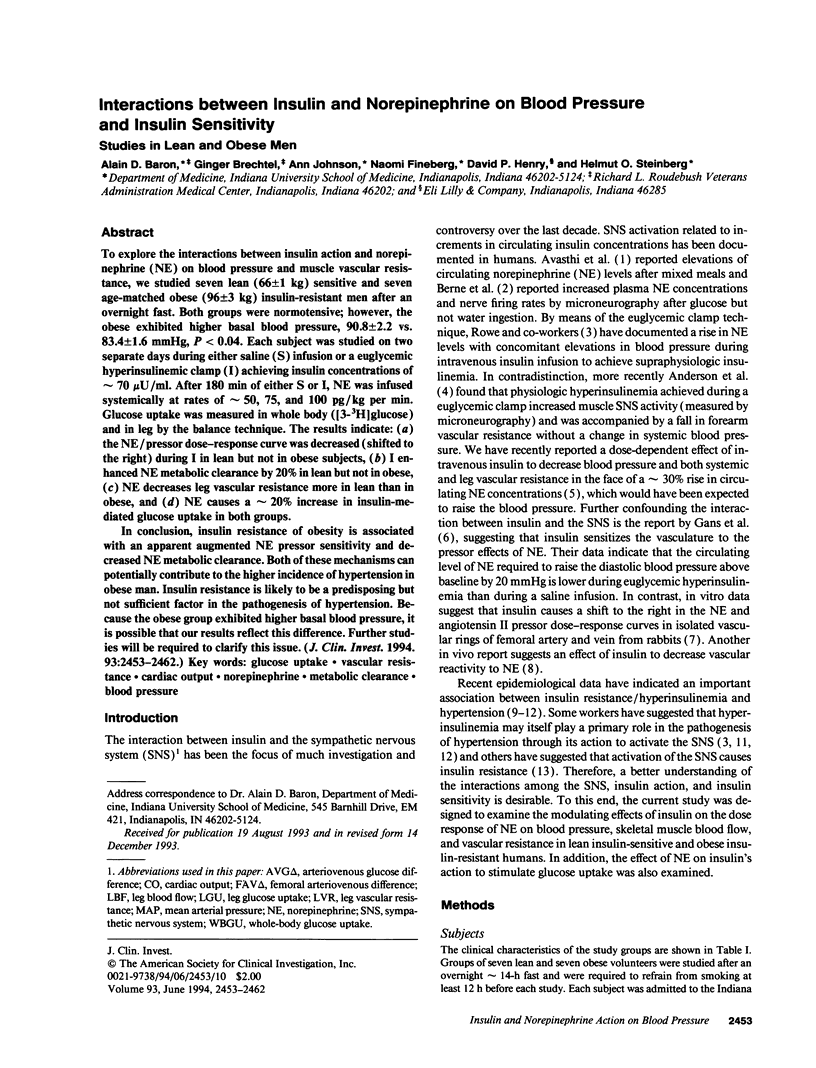
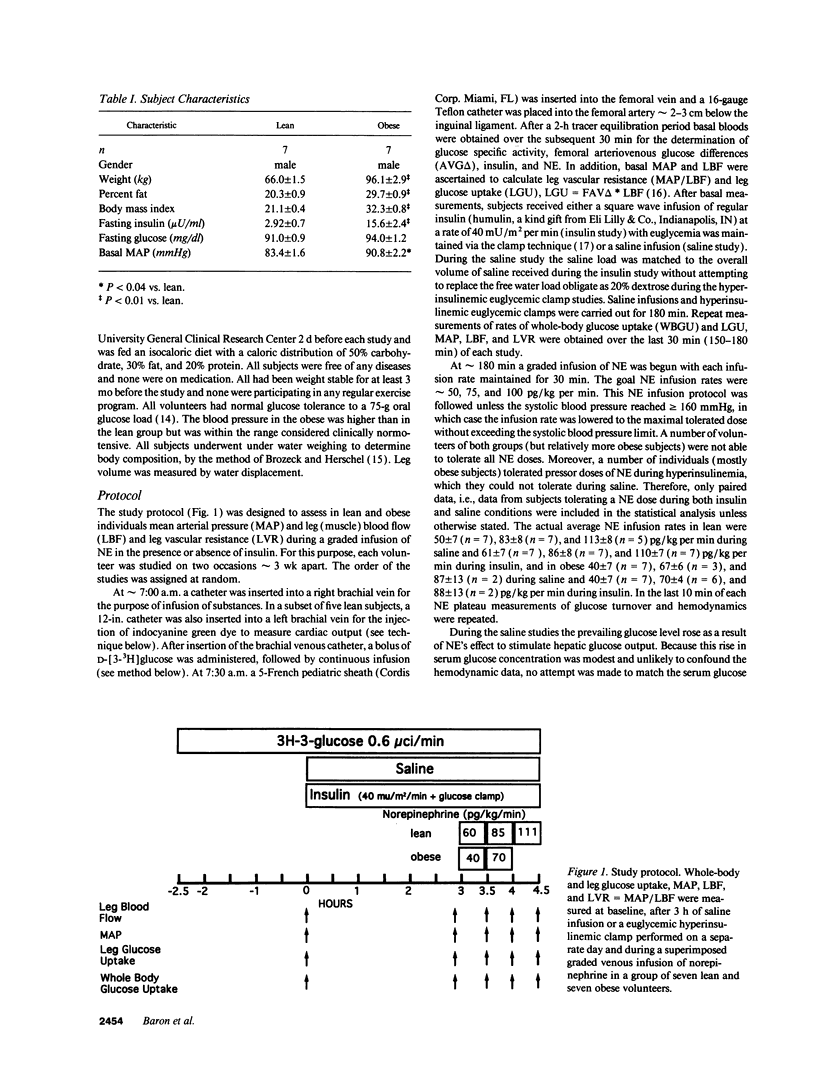
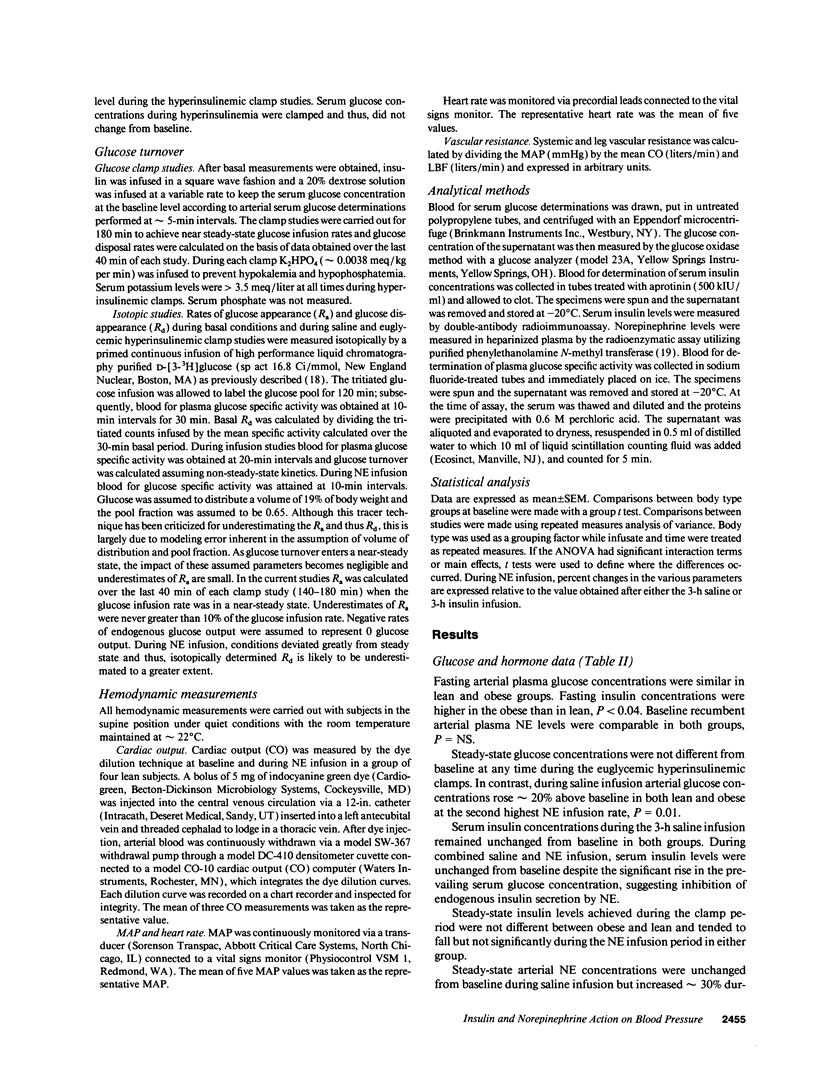
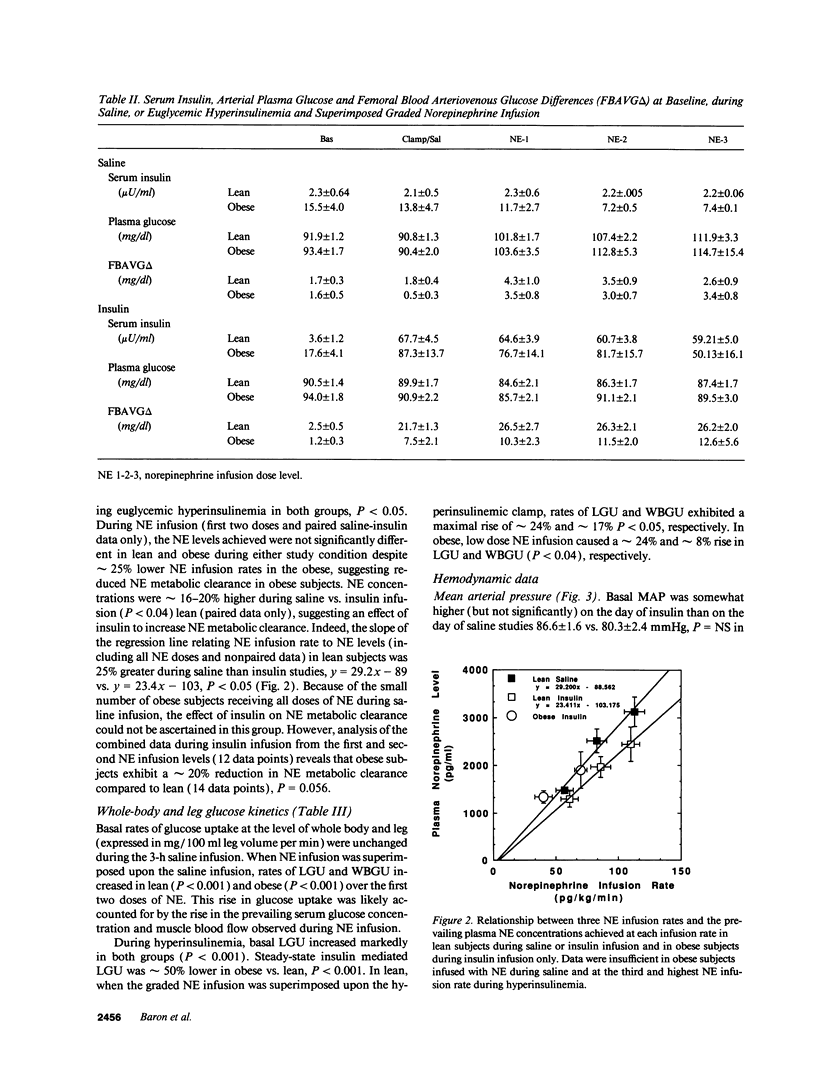
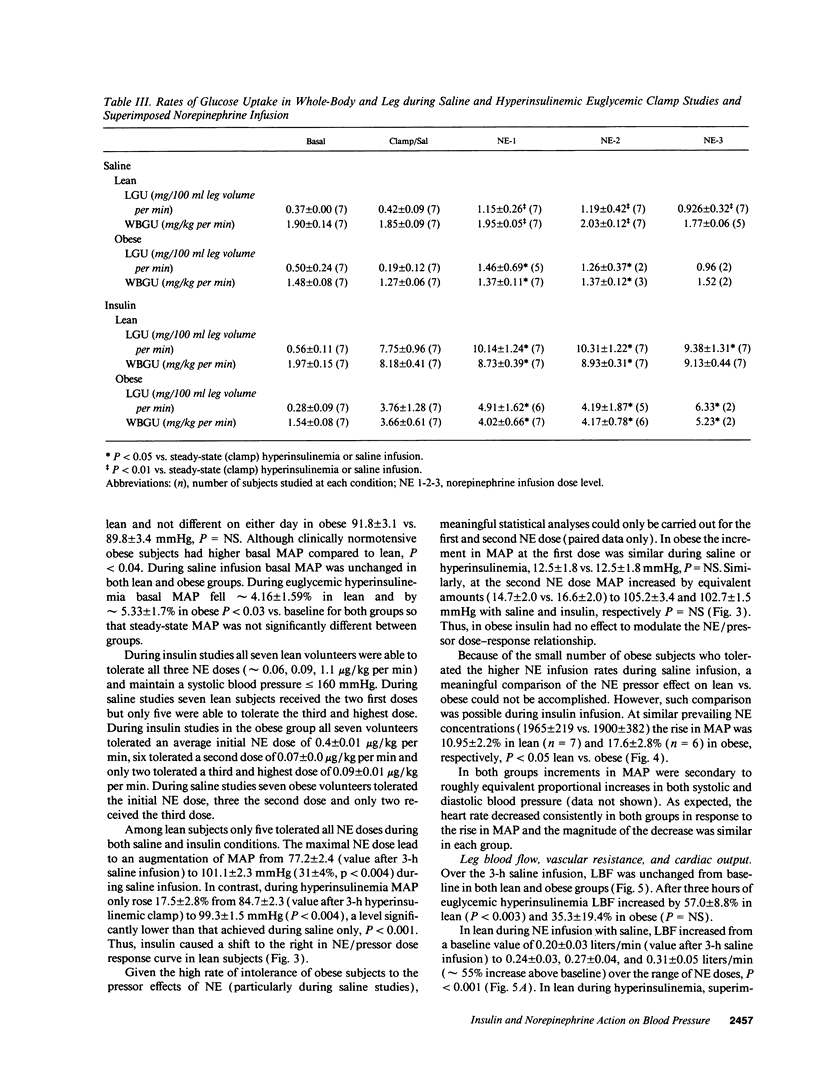
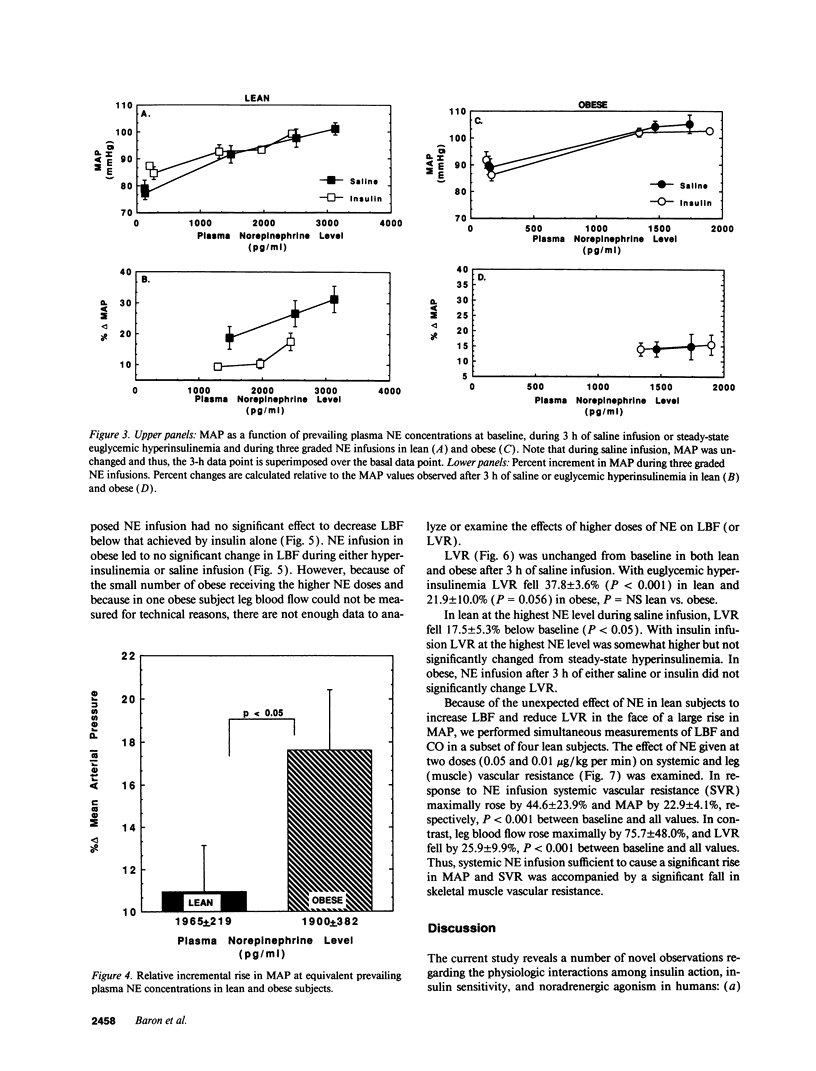
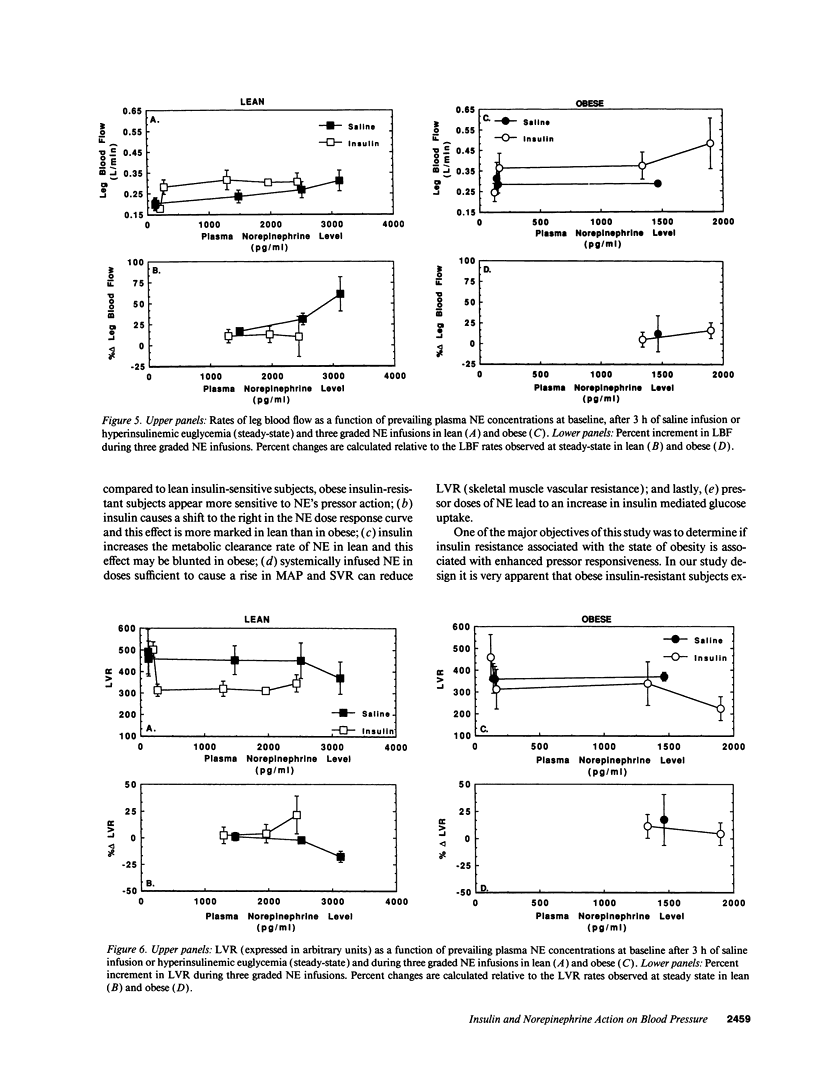
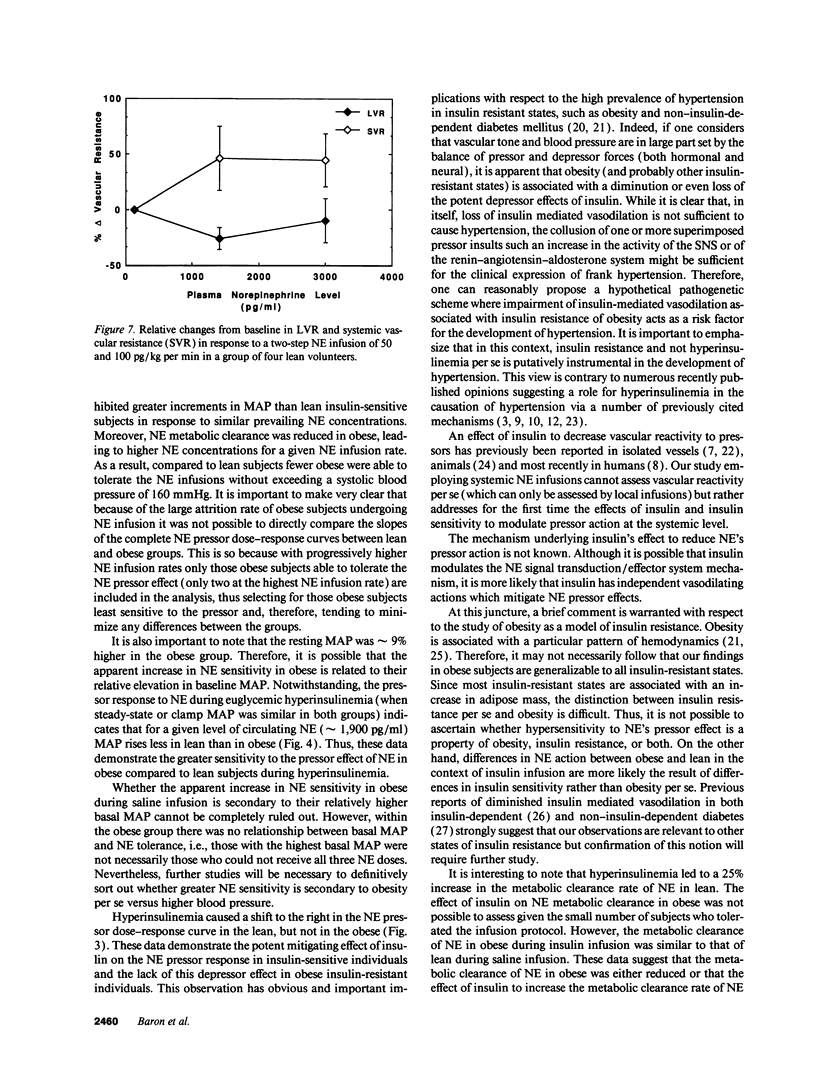
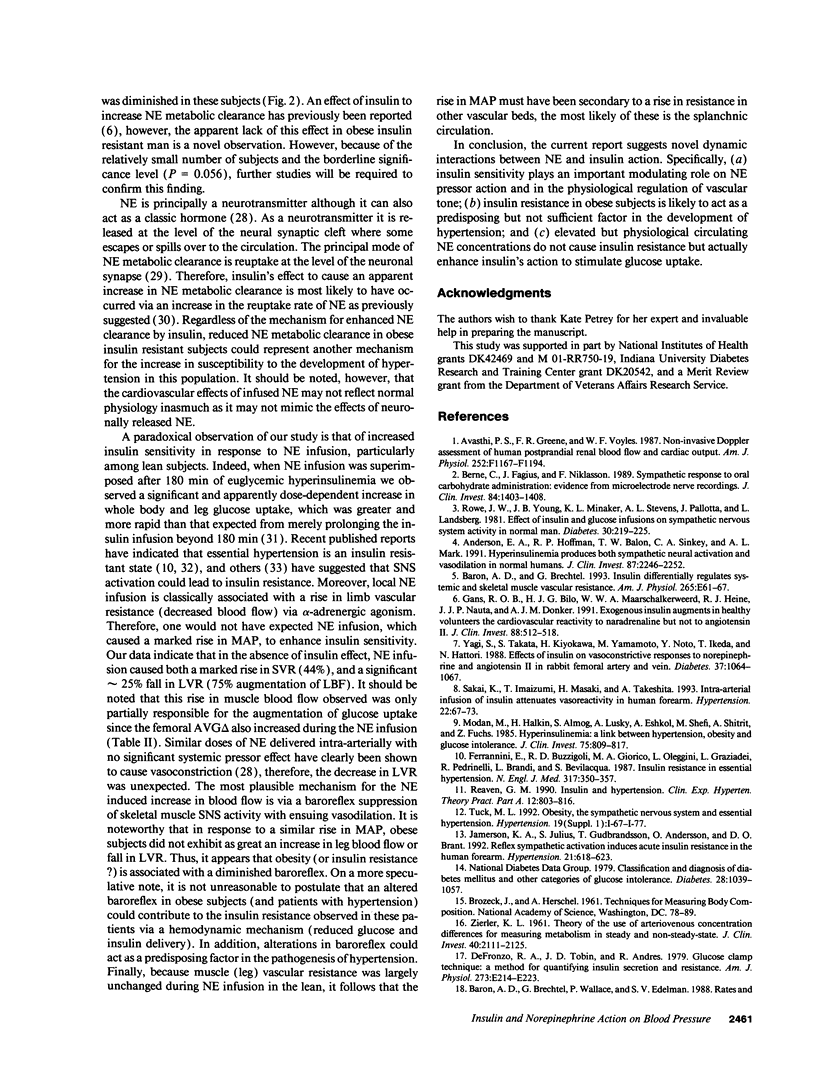
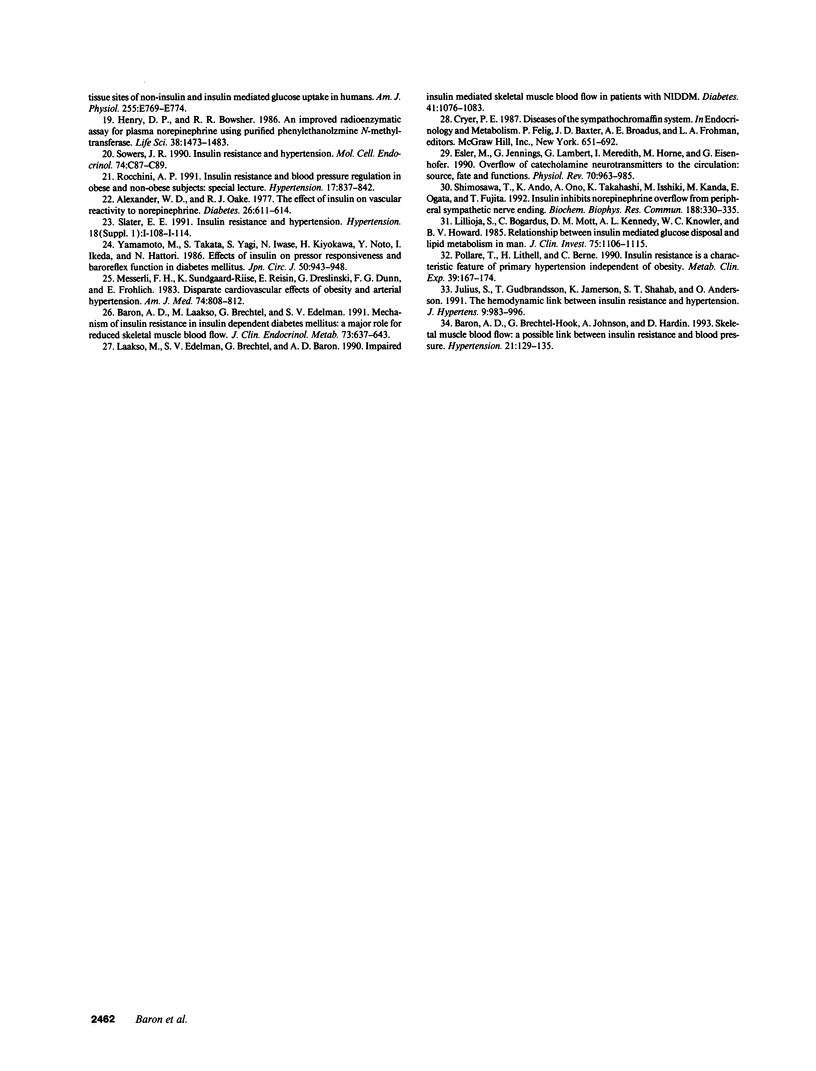
Selected References
These references are in PubMed. This may not be the complete list of references from this article.
- Alexander W. D., Oake R. J. The effect of insulin on vascular reactivity to norepinephrine. Diabetes. 1977 Jul;26(7):611–614. doi: 10.2337/diab.26.7.611. [DOI] [PubMed] [Google Scholar]
- Anderson E. A., Hoffman R. P., Balon T. W., Sinkey C. A., Mark A. L. Hyperinsulinemia produces both sympathetic neural activation and vasodilation in normal humans. J Clin Invest. 1991 Jun;87(6):2246–2252. doi: 10.1172/JCI115260. [DOI] [PMC free article] [PubMed] [Google Scholar]
- Baron A. D., Brechtel-Hook G., Johnson A., Hardin D. Skeletal muscle blood flow. A possible link between insulin resistance and blood pressure. Hypertension. 1993 Feb;21(2):129–135. doi: 10.1161/01.hyp.21.2.129. [DOI] [PubMed] [Google Scholar]
- Baron A. D., Brechtel G. Insulin differentially regulates systemic and skeletal muscle vascular resistance. Am J Physiol. 1993 Jul;265(1 Pt 1):E61–E67. doi: 10.1152/ajpendo.1993.265.1.E61. [DOI] [PubMed] [Google Scholar]
- Baron A. D., Brechtel G., Wallace P., Edelman S. V. Rates and tissue sites of non-insulin- and insulin-mediated glucose uptake in humans. Am J Physiol. 1988 Dec;255(6 Pt 1):E769–E774. doi: 10.1152/ajpendo.1988.255.6.E769. [DOI] [PubMed] [Google Scholar]
- Baron A. D., Laakso M., Brechtel G., Edelman S. V. Mechanism of insulin resistance in insulin-dependent diabetes mellitus: a major role for reduced skeletal muscle blood flow. J Clin Endocrinol Metab. 1991 Sep;73(3):637–643. doi: 10.1210/jcem-73-3-637. [DOI] [PubMed] [Google Scholar]
- Berne C., Fagius J., Niklasson F. Sympathetic response to oral carbohydrate administration. Evidence from microelectrode nerve recordings. J Clin Invest. 1989 Nov;84(5):1403–1409. doi: 10.1172/JCI114313. [DOI] [PMC free article] [PubMed] [Google Scholar]
- DeFronzo R. A., Tobin J. D., Andres R. Glucose clamp technique: a method for quantifying insulin secretion and resistance. Am J Physiol. 1979 Sep;237(3):E214–E223. doi: 10.1152/ajpendo.1979.237.3.E214. [DOI] [PubMed] [Google Scholar]
- Esler M., Jennings G., Lambert G., Meredith I., Horne M., Eisenhofer G. Overflow of catecholamine neurotransmitters to the circulation: source, fate, and functions. Physiol Rev. 1990 Oct;70(4):963–985. doi: 10.1152/physrev.1990.70.4.963. [DOI] [PubMed] [Google Scholar]
- Ferrannini E., Buzzigoli G., Bonadonna R., Giorico M. A., Oleggini M., Graziadei L., Pedrinelli R., Brandi L., Bevilacqua S. Insulin resistance in essential hypertension. N Engl J Med. 1987 Aug 6;317(6):350–357. doi: 10.1056/NEJM198708063170605. [DOI] [PubMed] [Google Scholar]
- Gans R. O., Bilo H. J., von Maarschalkerweerd W. W., Heine R. J., Nauta J. J., Donker A. J. Exogenous insulin augments in healthy volunteers the cardiovascular reactivity to noradrenaline but not to angiotensin II. J Clin Invest. 1991 Aug;88(2):512–518. doi: 10.1172/JCI115333. [DOI] [PMC free article] [PubMed] [Google Scholar]
- Henry D. P., Bowsher R. R. An improved radioenzymatic assay for plasma norepinephrine using purified phenylethanolamine N-methyltransferase. Life Sci. 1986 Apr 21;38(16):1473–1483. doi: 10.1016/0024-3205(86)90560-6. [DOI] [PubMed] [Google Scholar]
- Jamerson K. A., Julius S., Gudbrandsson T., Andersson O., Brant D. O. Reflex sympathetic activation induces acute insulin resistance in the human forearm. Hypertension. 1993 May;21(5):618–623. doi: 10.1161/01.hyp.21.5.618. [DOI] [PubMed] [Google Scholar]
- Julius S., Gudbrandsson T., Jamerson K., Tariq Shahab S., Andersson O. The hemodynamic link between insulin resistance and hypertension. J Hypertens. 1991 Nov;9(11):983–986. doi: 10.1097/00004872-199111000-00001. [DOI] [PubMed] [Google Scholar]
- Laakso M., Edelman S. V., Brechtel G., Baron A. D. Impaired insulin-mediated skeletal muscle blood flow in patients with NIDDM. Diabetes. 1992 Sep;41(9):1076–1083. doi: 10.2337/diab.41.9.1076. [DOI] [PubMed] [Google Scholar]
- Lillioja S., Bogardus C., Mott D. M., Kennedy A. L., Knowler W. C., Howard B. V. Relationship between insulin-mediated glucose disposal and lipid metabolism in man. J Clin Invest. 1985 Apr;75(4):1106–1115. doi: 10.1172/JCI111804. [DOI] [PMC free article] [PubMed] [Google Scholar]
- Messerli F. H., Sundgaard-Riise K., Reisin E., Dreslinski G., Dunn F. G., Frohlich E. Disparate cardiovascular effects of obesity and arterial hypertension. Am J Med. 1983 May;74(5):808–812. doi: 10.1016/0002-9343(83)91071-9. [DOI] [PubMed] [Google Scholar]
- Modan M., Halkin H., Almog S., Lusky A., Eshkol A., Shefi M., Shitrit A., Fuchs Z. Hyperinsulinemia. A link between hypertension obesity and glucose intolerance. J Clin Invest. 1985 Mar;75(3):809–817. doi: 10.1172/JCI111776. [DOI] [PMC free article] [PubMed] [Google Scholar]
- Pollare T., Lithell H., Berne C. Insulin resistance is a characteristic feature of primary hypertension independent of obesity. Metabolism. 1990 Feb;39(2):167–174. doi: 10.1016/0026-0495(90)90071-j. [DOI] [PubMed] [Google Scholar]
- Reaven G. M. Insulin and hypertension. Clin Exp Hypertens A. 1990;12(5):803–816. doi: 10.3109/10641969009073501. [DOI] [PubMed] [Google Scholar]
- Rocchini A. P. Insulin resistance and blood pressure regulation in obese and nonobese subjects. Special lecture. Hypertension. 1991 Jun;17(6 Pt 2):837–842. doi: 10.1161/01.hyp.17.6.837. [DOI] [PubMed] [Google Scholar]
- Rowe J. W., Young J. B., Minaker K. L., Stevens A. L., Pallotta J., Landsberg L. Effect of insulin and glucose infusions on sympathetic nervous system activity in normal man. Diabetes. 1981 Mar;30(3):219–225. doi: 10.2337/diab.30.3.219. [DOI] [PubMed] [Google Scholar]
- Sakai K., Imaizumi T., Masaki H., Takeshita A. Intra-arterial infusion of insulin attenuates vasoreactivity in human forearm. Hypertension. 1993 Jul;22(1):67–73. doi: 10.1161/01.hyp.22.1.67. [DOI] [PubMed] [Google Scholar]
- Shimosawa T., Ando K., Ono A., Takahashi K., Isshiki M., Kanda M., Ogata E., Fujita T. Insulin inhibits norepinephrine overflow from peripheral sympathetic nerve ending. Biochem Biophys Res Commun. 1992 Oct 15;188(1):330–335. doi: 10.1016/0006-291x(92)92389-f. [DOI] [PubMed] [Google Scholar]
- Sowers J. R. Insulin resistance and hypertension. Mol Cell Endocrinol. 1990 Dec 3;74(2):C87–C89. doi: 10.1016/0303-7207(90)90110-t. [DOI] [PubMed] [Google Scholar]
- Yagi S., Takata S., Kiyokawa H., Yamamoto M., Noto Y., Ikeda T., Hattori N. Effects of insulin on vasoconstrictive responses to norepinephrine and angiotensin II in rabbit femoral artery and vein. Diabetes. 1988 Aug;37(8):1064–1067. doi: 10.2337/diab.37.8.1064. [DOI] [PubMed] [Google Scholar]
- Yamamoto M., Takata S., Yagi S., Iwase N., Kiyokawa H., Noto Y., Ikeda T., Hattori N. Effects of insulin on pressor responsiveness and baroreflex function in diabetes mellitus. Jpn Circ J. 1986 Oct;50(10):943–948. doi: 10.1253/jcj.50.943. [DOI] [PubMed] [Google Scholar]
- Zierler K. L. THEORY OF THE USE OF ARTERIOVENOUS CONCENTRATION DIFFERENCES FOR MEASURING METABOLISM IN STEADY AND NON-STEADY STATES. J Clin Invest. 1961 Dec;40(12):2111–2125. doi: 10.1172/JCI104437. [DOI] [PMC free article] [PubMed] [Google Scholar]


